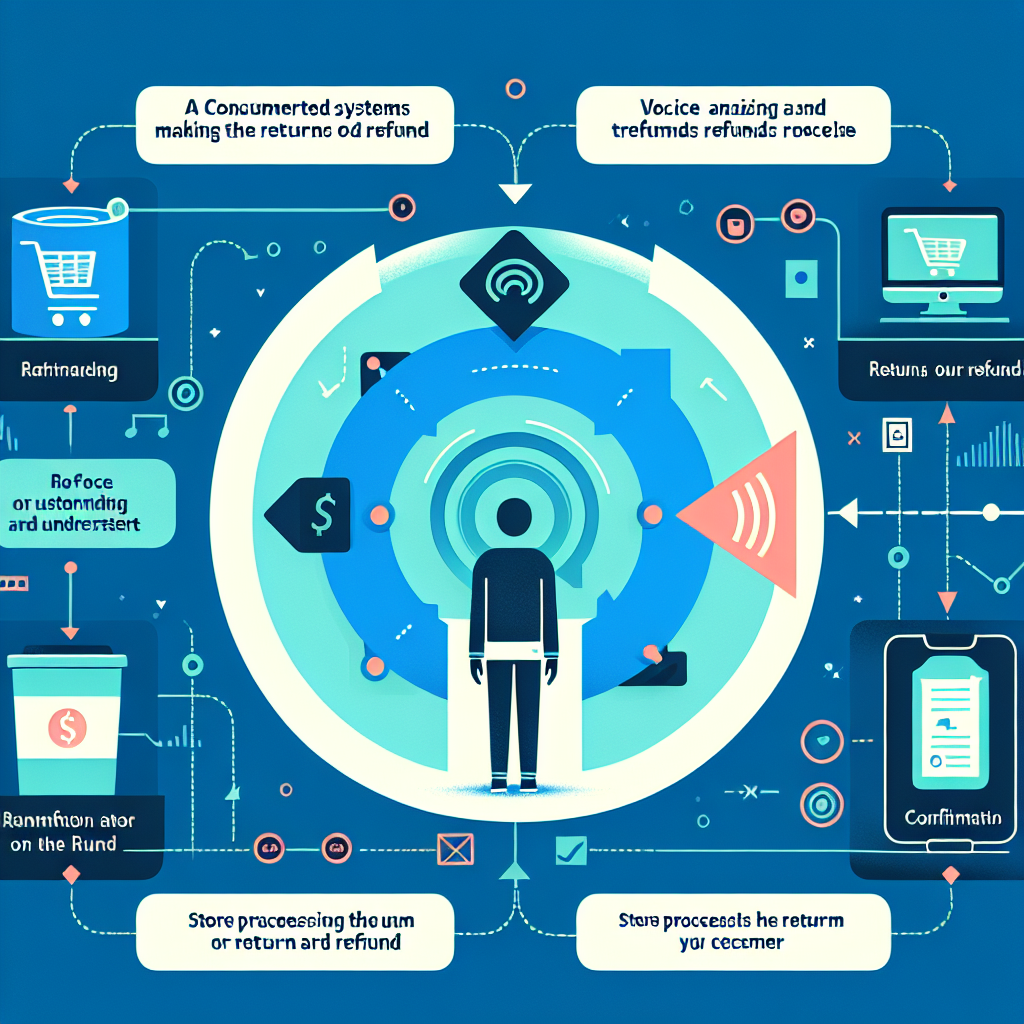
With the rise of digital innovation, varying sectors of businesses have begun leveraging the power of AI and machine learning to provide exceptional customer service. One of these technological advancements is voice-activated technology, revolutionizing mundane processes and enhancing interaction with customers.Read more here.
Seamless, efficient, and accessible, these voice-activated systems provide an opportunity for businesses to streamline operations, particularly in regards to an otherwise complicated returns and refunds process. Pioneering companies are revolutionizing their traditional customer service by incorporating voice-activated mechanisms that respond to customer queries promptly and effectively.

These voice-activated systems, integrated with efficient AI, not only understand and respond to customer queries but also initiate transactions such as returns and refunds, thereby reducing the effort customers would have to put in to get their issues resolved. They essentially serve as digital assistants, taking commands, answering questions, and executing tasks quickly with just a voice command.
A decision to move towards a voice-activated system means adding a touch of personalization and convenience, reaffirming the importance of centring customer service operations around the customer's comfort and satisfaction. Gartner predicts that by 2022, 70% of customer interactions will involve emerging technologies such as machine learning applications, chatbots and mobile messaging, up from 15% in 2018.Voice-activated processes are only the first step to a completely digitalized era of customer service.
Whether your business is large or small, investing in the future of customer service with voice-activated technology can lead to satisfied customers, efficient operations, and ultimately, an edge over the competition.Learn more here.
With technology advancing at dizzying speeds, Voice-Activated Artificial Intelligence (AI) is transforming traditional phone interactions while streamlining complicated processes. One significant application lies in the sector of returns and refunds, typically a source of immense customer dissatisfaction owing to the intricate and time-consuming nature of traditional phone-based processes.
Employing voice-activated AI receptionists for returns and refunds could very well be the game-changer we've been looking for. Previously, customers dealing with return requests had to navigate through a series of automated responses, or worse, face prolonged wait times just to speak with a human representative. This method frequently leads to escalations, customer disappointments, and brand disillusionment. Nowadays, however, technology is not only capable of recognizing human speech but also understanding its nuances, thanks to AI enabled machine learning algorithms.
Voice-activated AI platforms like Nuance can classify and process customer requests in real-time, further reducing service time while enhancing customer experience. Customers can simply verbalize their return or refund request, and the AI system identifies the underlying intent, matches it to the correct procedure, and initiates the needed action. No longer must customers endure the tedious touch-tone menus, establishing a user-centric return or refund process.
Furthermore, these innovative voice-based systems can potentially save companies enormous amounts of money. According to a report by IBM, businesses waste billions of dollars annually due to inefficient call center operations. Deploying AI responses to commonly faced issues in returns and refunds can help companies alleviate some of these costs.
In short, voice-activated AI receptionists can revolutionize the conventional method of phone-based return and refund systems. This technology not only streamlines the procedure making it efficient but also positions it to be more customer-centric. The future of efficient business processes lies in full throttled adoption of Voice-Activated AI systems.
Voice-Activated Returns and Refunds are creating a revolution in customer service. They offer a host of features aimed at streamlining the return and refund process, reducing overheads, and increasing customer satisfaction.
One of the most significant features of Voice-Activated Returns is real-time processing. These systems can process return requests as they come in, eliminating delays, and reducing the time customers spend waiting for refunds. Studies show that this speed and efficiency directly impact customer satisfaction and loyalty.

Another standout feature of these systems is their ability to understand natural language. This means that they can interpret and act on customer instructions as they would be spoken in everyday conversation. No more frustrating keyword prompts or rigid command structures; customers can converse with the system as naturally as they would with a human operator. This, coupled with voice recognition technology, can hugely enhance the user experience.
Voice-Activated Returns systems are also designed to integrate seamlessly with pre-existing customer relationship management (CRM) and inventory systems. This not only allows for more accurate tracking of returns but also ensures that inventory levels are updated in real time. Additionally, by utilizing data from the CRM, the system can offer personalized options and advice to each customer based on their purchase history or preferences. Integration benefits cannot be overstated, as it leads to increased company efficiency and an optimized return process.
In conclusion, Voice-Activated Returns and Refunds hold the potential to drastically improve the efficiency of telephone-based customer service processes and enhance the overall customer experience. Their real-time processing capabilities, natural language understanding, and integration with existing systems make them an indispensable asset for businesses looking to stay competitive in today's fast-paced digital world.
As online shopping and digital transactions continue to rise, more businesses turn to advanced technologies to optimize customer service. Voice-activated returns and refunds system, advanced artificial intelligence (AI) technology streamlining the traditional phone-based refund and return processes, is making a significant impact.
One case study that stands out in the successful implementation of this system is Amazon. Amazon goes beyond conventional customer service channels with its Alexa customer service support. By simply saying, "Alexa, where's my refund?", customers can instantly get updates about their refund status. This voice-activated system has proved effective in speeding up and enhancing their return and refund process, thereby boosting customer satisfaction.
Another impressive example is Google's AI program, Google Assistant. Businesses using Google's ecosystem can integrate this tool into their customer service approaches. For instance, Google Express, Google's shopping service, uses Google Assistant for faster, more efficient return and refund processes. Users simply need to tell Google Assistant to start a return or check the status of their refund.
Telecom industry has not stayed behind in incorporating this innovative technology. Verizon, a leading telecommunications company, incorporated voice-activated customer service for handling various customer requests, including refunds. The advanced voice recognition system Verizon's Interactive Voice Response(IVR) uses AI and machine learning to grasp customer queries, facilitating a simple, speedy return and refund process.
These real-world examples highlight how businesses across sectors are significantly improving their returns and refunds processes by implementing voice-activated systems. As such systems become more sophisticated and widely adopted, the future of customer service looks to be heading towards greater accuracy, efficiency, and convenience.
Transitioning traditional phone-based customer service interfaces to voice-activated solutions opens up a world of opportunities. Implementing these systems thoughtfully and effectively is key to achieving maximum efficiency and return on investment. This guide will walk you through best practices to make this transition smooth and successful.

A key element to consider is user-friendliness. Your customers are your number one priority, and a system that is tricky or complicated to navigate will quickly deter their use. Ensure your voice-activated system has clear, understandable prompts and simple responses. Provide your customers with a dynamic and adaptive user experience.
Second, balance automation and human interaction. A fully automated system may seem efficient but it can often be frustrating for the customer, especially if their request is complex and requires a more personalized touch. Human interaction should complement automation for a harmonious customer care environment.
Finally, after the implementation, monitor and improve. The journey doesn't end once you've integrated a voice-activated system. Keep refining your systems by collecting and analyzing customer feedback. Use voice of the customer (VOC) practices to understand where your system excels and where it needs tweaking.
An effective voice-activated system can not only streamline your phone-based process but can also transform your customer experience. Following these best practices, you can ensure a successful transition and elevate your customer service to new heights.
As we continue to explore the infinite frontiers of technology, voice-activated systems are set to play an increasingly important role across multiple sectors of the global economy. With sophisticated advancements, voice technology is poised to redefine traditional business operations, creating an expedited bridge between consumers and service providers.
One such arena where voice technology is making notable strides is phone-based customer service. Already, certain corporations have begun to employ voice-activated AI technologies to facilitate a seamless and more interactive return and refund process. By simplifying these processes, companies can boost customer satisfaction and engender loyalty.
What does the future hold for voice activation? Beyond the prospects of streamlining returns and refunds, voice tech is looking at being integrated within the core functionalities of many businesses. The eventual goal? To create a holistic voice-activated environment that takes customer interactions to the next level.
For instance, the emergence of conversational AI, featuring natural language understanding, pushes the limits of what voice-activated systems can achieve. By interacting with consumers in an increasingly 'human' manner, businesses can provide a more personalized service experience.
Simultaneously, privacy remains a paramount concern. To address this issue, businesses are investing in enhanced security protocols to ensure that voice-activated transactions will involve minimal or no personal data sharing, thereby protecting user confidentiality.
With these technological advancements, we can expect voice-activated returns and refunds to become standard in the foreseeable future. The continued growth of voice technology will not only rewrite the way businesses operate but also redefine how companies and consumers interact on a day-to-day basis.
Start your free trial for My AI Front Desk today, it takes minutes to setup!








